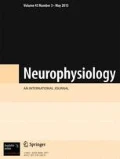Among eight recently synthesized 3-phthalimidoacyloxy- and phthalimidoacyloxyethoxy-1,2-dihydro-3H-1,4-benzodiazepin-2-ones, three compounds that enhanced the indices of cognitive functions in albino rats by 24-43%, as compared with those in control animals, were found. In the Morris water maze test, these agents used in doses of 10 mg/kg positively influenced the index of long-term memory in contrast to the hormone leptin (10 nM) that enhanced the index of short-term memory but did not influence long-term memory. Pyracetam enhanced the indices of both short-term memory and long-term memory, but only in a much greater dose (400 mg/kg). Injections of the above-mentioned three tested compounds into rats resulted in a decrease in the power of the delta EEG rhythm and also in rises in the powers of theta and (especially) beta oscillations. All eight tested compounds (in doses 10 mg/kg) demonstrated clearly pronounced antihypoxic effects under conditions of acute hypoxia in a closed space test in experiments on mice. Two compounds showed the maximum efficiency; those increased the survival time of mice by 76% and 50%, respectively, as compared with the control. Therefore, the eight tested compounds demonstrate, along with high antihypoxic efficiency, a specific aspect of pharmacological activity somewhat unusual for benzodiazepins; these compounds improve the long-term memory and learning capability and exert specific effects on the EEG characteristics. These compounds are characterized by low toxicity; their LD50 exceeds 550 mg/kg.
Similar content being viewed by others
References
A. V. Bogatskii, S. A. Andronati, and N. Ya. Golovenko, Tranquilizers [in Russian], Naukova Dumka, Kyiv (1980).
S. A. Andronati, G. Ya. Avrutskii, and A. V. Bogatskii, Phenazepam [in Russian], Naukova Dumka, Kyiv (1982).
S. A. Andronati, T. A. Voronina, N. Ya. Golovenko, et al., Gidazepam, [in Russian], Naukova Dumka, Kyiv (1992).
T. L. Karaseva, L. V. Popova, and S. A. Andronati, “Examination of the effects of anxiolytics, derivatives of 1,4-benzodiazepins, on the processes of memory in experiments on rats,” Liky, 3/4, 84-86 (2003).
A. A. Kazakova, T. L. Karaseva, V. I. Pavlovsky, et al., “Effects of derivatives of cis-3-arylidene(hetarylidene)-1,2-dihydro-3Н-1,4-benzodiazepin-2-ones on cognitive functions of rats,” Visn. Psykhiatr. Psykhopharmakoter., 17, No. 1, 24-26 (2010).
T. L. Karaseva, V. S. Bitenskii, S. G. Soboeva, et al., “Neurotropic properties of leptin and its effects on pharmacological activity of agonists of benzodiazepin and serotonin (5-HT1a) receptors,” Visn. Psykhiatr. Psykhopharmakoter., No. 2, (25), 50-56 (2014).
E. A. Shesterenko, I. I. Romanovska, V. I. Pavlovsky, et al., “Interrelation between 3-hydroxy-1,4-benzodiazepin-2-one ester structure on their hydrolysis by carboxyl esterase,” Biotechnol. Аcta, 6, No. 2, 80-84 (2013).
Patent of Russia, The Use of Leptin Antagonists for Medical Treatment of Resistance to Insulin in Type-II Diabetes [in Russian], I. Ertl, G. Praibish, and G. Myuller, Published on March 27, 2003, Byull. No. RU2201249C2.
J. Simpson and J. P. Kelly, “Impact of environmental enrichment in laboratory rats – behavioral and neurochemical aspects,” Behav. Brain Res., 222, No. 1, 246-264 (2011).
D. R. Morris, “Developments of a water maze procedure for studying spatial learning in the rat,” J. Neurosci. Methods, 11, No. 1, 47-60 (1984).
I. G. Lilp, F. Z. Bizikoeva, I. I. Poletaeva, and V. I. Ivanov, “Interlinear difference in cognitive ability between 101/HY and СВА mice as inferred from the water maze (modified Morris) test,” Byull.Éksp. Biol. Med., 124, 666-668 (1997).
E. V. Mitroshina, M. V. Vedunova, A. A. Mironov, et al., “Neuroprotective action of cannabinoid of N-arachidonoyl dopamine in modelling of acute hypobaric hypoxia of the brain,” Neirol. Vestn., 44, No. 1, 14-19 (2012).
M. Steriade, P. Gloor, R. R. Llinas, et al., “Basic mechanisms of cerebral rhythmic activities,” Electroencephalogr. Clin. Neurophysiol., 76, 481-508 (1990).
B. Nickel, H. O. Borbe, and I. Szelenyi, “Effect of selegiline and desmethyl-selegiline on cortical electric activity in rats,” J. Neural Transm., 32, 139-144 (1990).
S. N. Lapach, A. V. Chubenko, and P. N. Babich, Statistical Methods in Medical/Biological Studies Using Excel [in Russian], Morion, Kyiv (2001).
Author information
Authors and Affiliations
Corresponding author
Rights and permissions
About this article
Cite this article
Andronati, S.A., Karaseva, T.L., Krivenko, Y.R. et al. Nootropic and Antihypoxic Properties of Novel Derivatives of 1,2-Dihydro-3H-1,4-Benzodiazepin-2-one. Neurophysiology 49, 405–411 (2017). https://doi.org/10.1007/s11062-018-9703-9
Received:
Published:
Issue Date:
DOI: https://doi.org/10.1007/s11062-018-9703-9




